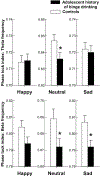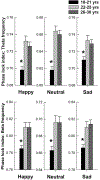Phase locking of event-related oscillations is decreased in both young adult humans and rats with a history of adolescent alcohol exposure
- PMID: 30884076
- PMCID: PMC6751029
- DOI: 10.1111/adb.12732
Phase locking of event-related oscillations is decreased in both young adult humans and rats with a history of adolescent alcohol exposure
Abstract
Alcohol exposure typically begins in adolescence, and frequent binge drinking has been associated with health risk behaviors including alcohol use disorders (AUDs). Few studies have documented the effects of a history of adolescent binge drinking on neurophysiological consequences in young adulthood. Synchrony of phase (phase locking (PL)) of event-related oscillations (EROs) within and between different brain areas reflects communication exchange between neural networks and is a sensitive measure of adolescent development in both rats and humans, and thus may be a good translational measure of the potential harmful effects of alcohol exposure during adolescence. In this study, EROs were collected from 1041 young adults of Mexican American and American Indian ancestry (age 18-30 years) with and without a history of adolescent binge drinking (five drinks for boys and four for girls per occasion at least once per month) and in 74 young adult rats with and without a history of 5 weeks of adolescent alcohol vapor exposure. PL of theta and beta frequencies between frontal and parietal cortex were estimated using an auditory-oddball paradigm in the rats and a visual facial expression paradigm in the humans. Significantly lower PL between frontal and parietal cortices in the theta frequencies was seen in both the humans and the rats with a history of adolescent alcohol exposure as compared with their controls. These findings suggest that alcohol exposure during adolescence may result in decreases in synchrony between cortical neuronal networks, suggesting a developmental delay, in young adult humans and in rats.
Keywords: adolescence; alcohol; event-related oscillations.
© 2019 Society for the Study of Addiction.
Conflict of interest statement
The authors declare no conflicts of interest.
Figures





Similar articles
-
CR-19-0950: Event-related responses to alcohol-related stimuli in Mexican-American young adults: Relation to age, gender, comorbidity and "dark side" symptoms.Drug Alcohol Depend. 2019 Sep 1;202:76-86. doi: 10.1016/j.drugalcdep.2019.06.001. Epub 2019 Jul 6. Drug Alcohol Depend. 2019. PMID: 31323376 Free PMC article.
-
Decreases in energy and increases in phase locking of event-related oscillations to auditory stimuli occur during adolescence in human and rodent brain.Dev Neurosci. 2014;36(3-4):175-95. doi: 10.1159/000358484. Epub 2014 May 9. Dev Neurosci. 2014. PMID: 24819672 Free PMC article.
-
Acute low-level alcohol consumption reduces phase locking of event-related oscillations in rodents.Behav Brain Res. 2017 Jul 14;330:25-29. doi: 10.1016/j.bbr.2017.05.007. Epub 2017 May 8. Behav Brain Res. 2017. PMID: 28495609 Free PMC article.
-
Adolescent alcohol exposure: Are there separable vulnerable periods within adolescence?Physiol Behav. 2015 Sep 1;148:122-30. doi: 10.1016/j.physbeh.2015.01.027. Epub 2015 Jan 23. Physiol Behav. 2015. PMID: 25624108 Free PMC article. Review.
-
Adolescent Binge Drinking.Alcohol Res. 2018;39(1):5-15. Alcohol Res. 2018. PMID: 30557142 Free PMC article. Review.
Cited by
-
Time Course of Blood and Brain Cytokine/Chemokine Levels Following Adolescent Alcohol Exposure and Withdrawal in Rats.Alcohol Clin Exp Res. 2019 Dec;43(12):2547-2558. doi: 10.1111/acer.14209. Epub 2019 Oct 25. Alcohol Clin Exp Res. 2019. PMID: 31589333 Free PMC article.
-
CR-19-0950: Event-related responses to alcohol-related stimuli in Mexican-American young adults: Relation to age, gender, comorbidity and "dark side" symptoms.Drug Alcohol Depend. 2019 Sep 1;202:76-86. doi: 10.1016/j.drugalcdep.2019.06.001. Epub 2019 Jul 6. Drug Alcohol Depend. 2019. PMID: 31323376 Free PMC article.
-
Delta Event-Related Oscillations Are Related to a History of Extreme Binge Drinking in Adolescence and Lifetime Suicide Risk.Behav Sci (Basel). 2020 Oct 7;10(10):154. doi: 10.3390/bs10100154. Behav Sci (Basel). 2020. PMID: 33036364 Free PMC article.
-
Regulation of the deleterious effects of binge-like exposure to alcohol during adolescence by α7 nicotinic acetylcholine receptor agents: prevention by pretreatment with a α7 negative allosteric modulator and emulation by a α7 agonist in alcohol-preferring (P) male and female rats.Psychopharmacology (Berl). 2020 Sep;237(9):2601-2611. doi: 10.1007/s00213-020-05557-1. Epub 2020 Jun 30. Psychopharmacology (Berl). 2020. PMID: 32607619 Free PMC article.
-
PSPH-D-18-00526: Effect of a dual orexin receptor antagonist (DORA-12) on sleep and event-related oscillations in rats exposed to ethanol vapor during adolescence.Psychopharmacology (Berl). 2020 Oct;237(10):2917-2927. doi: 10.1007/s00213-019-05371-4. Epub 2019 Oct 28. Psychopharmacology (Berl). 2020. PMID: 31659377 Free PMC article.
References
-
- Basar E (1980) EEG-brain dynamics- Relation between EEG and Brain evoked potentials Elsevier/North-Holland Biomedical Press: Amsterdam.
-
- Basar E, Basar-Eroglu C, Karakas S, Schurmann M (2000) Brain oscillations in perception and memory. Int J Psychophysiol 35:95–124. - PubMed
-
- Basar E, Schurmann M, Sakowitz O (2001) The selectively distributed theta system: functions. Int J Psychophysiol 39:197–212. - PubMed
Publication types
MeSH terms
Substances
Grants and funding
LinkOut - more resources
Full Text Sources
Medical

